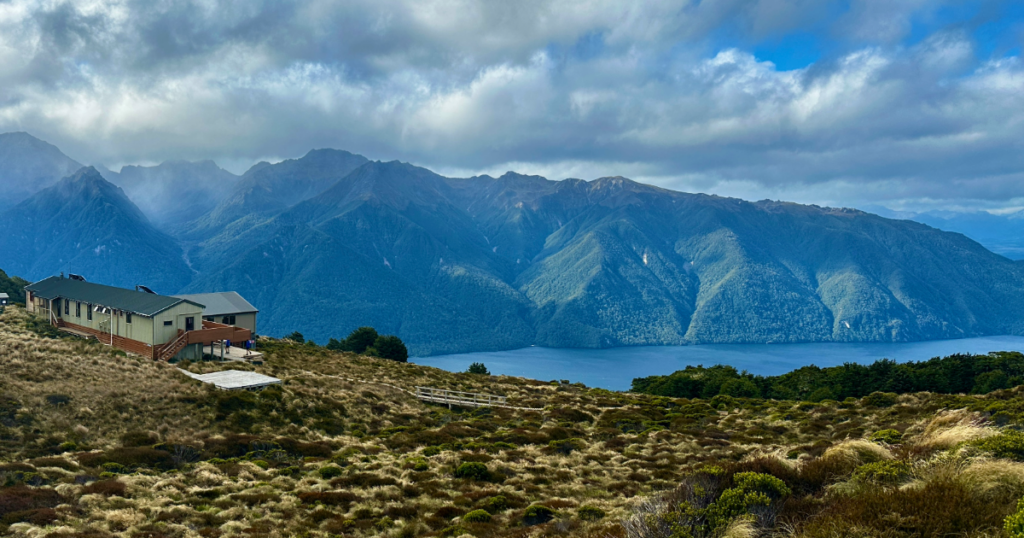Staying in the huts along the 4-day Kepler Track is a memorable part of the whole experience! After several hours of traversing mountain peaks, the Kepler Track huts are an inviting, glowing light at the end of the tunnel. They’re super rustic, but will feel like a 5-star luxury resort once you get there — trust me. Here’s what you can expect so you know just what to pack for the perfect Great Walk adventure in New Zealand.
This post may contain affiliate links. Booking through these links generates a small commission for me at no extra cost to you. Thanks for your support!
Facilities at the Kepler Track huts
There are three Kepler Track huts along the trail: Luxmore, Irisburn, and Moturau. Luxmore is the newest and it has an amazing view. (Pictured above.)
Each hut has a unique set up, but you can expect to share a room with about 20 people. There will be about 50 other people in the hut in total. The bunks are not assigned, so the sooner you get there, the better choice of bed you’ll have! This means you may even be separated from your hiking buddies, but there’s usually bunks in the same general vicinity if not right next to each other.
We took our time on the trails, stopping along the way to take in the views (and enjoy snacks). So we got to the huts later in the day and were pretty ready for bed at like 9 or 10 after cooking dinner. But I still recommend bringing a book and a deck of cards to pass the time. You won’t be able to scroll Insta!
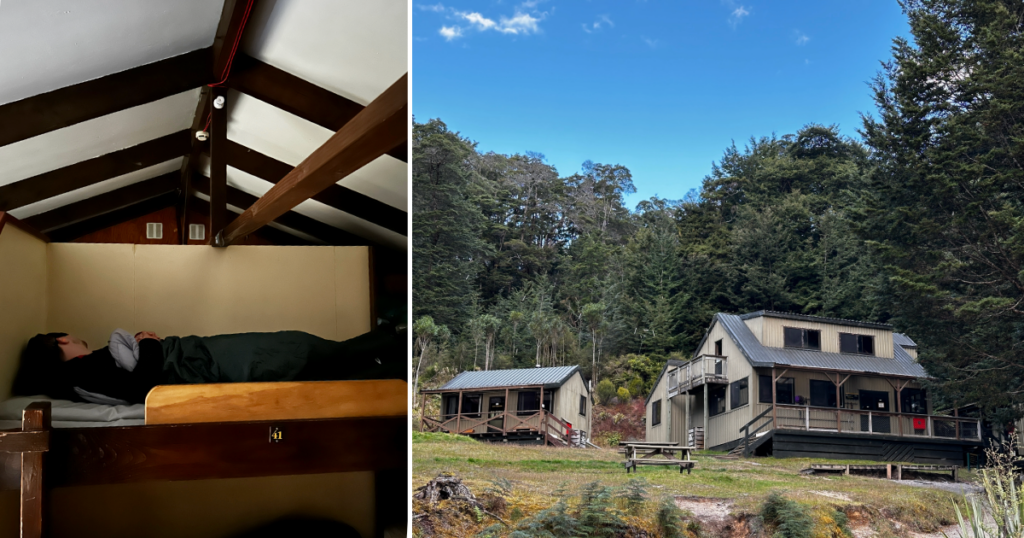
This is my partner, Chesney. I didn’t photograph a stranger sleeping. | Moturau Hut
Things the Kepler Track Huts DO have
- Clean drinking water (more on this below)
- Flushing toilets
- Gas burners for cooking*
- Dish soap, scrubbers, wet cloths
- Clothes lines/racks for drying clothes
- Fireplaces
- Windows with bug nets
- Toilet paper, hand soap, bins for feminine hygiene products
- There are also some toilets along the trail. (One with a serious view!)
Things the Kepler Huts DON'T have
- Showers
- Charging ports for any electronics
- *Lighters or matches for gas burners
- Cell service
- Sheets/bedding
- Towels
- Garbage bins
- Fridges
- Pots, pans, cutlery, dishes, etc.
- Cooking oil, coffee, salt, etc.
- Lights (solar, only on for brief periods)
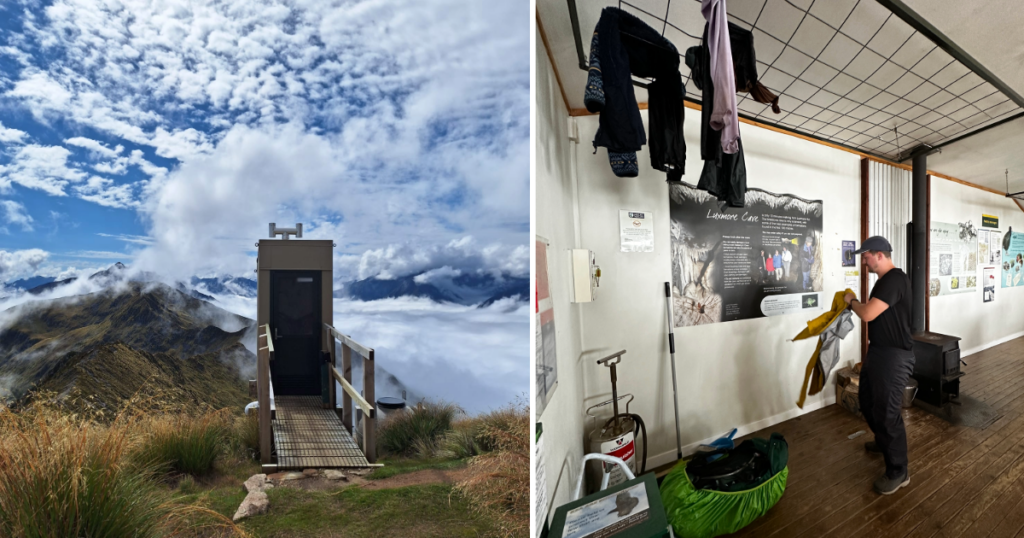
Probably the most scenic place for a bathroom. / Drying racks.
Cooking at the Kepler Track huts
All the Kepler Track hut kitchens have gas burners, but I was devastated to learn that they are not self-igniting. We didn’t pack any matches or a lighter, but fortunately, our hiking pals did, so we didn’t have to bug strangers when we wanted to cook. Lesson learned: always pack matches!
You also need to bring your own cooking gear: pots, cutlery, cups. Every hut kitchen has a ton of bench and shelving space so you can leave your kit there overnight rather than packing/unpacking over and over. And there are lots of burners and space for food prep — we never had an issue with crowding or waiting to use a stove.
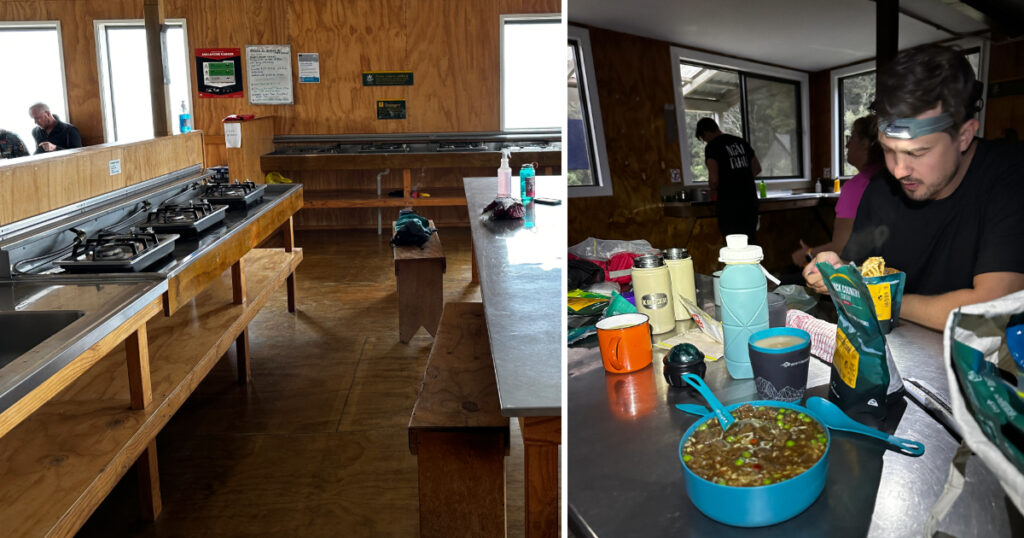
The tap water is clean and safe for drinking. DOC legally has to put up signs at every campsite or hut across New Zealand saying the water isn’t drinkable until you boil it. And that is true for many places. But the DOC workers who live on site will tell you it’s totally safe to drink, and I can vouch for that from personal experience as well. It’s like, fresh mountain water, so it doesn’t get much cleaner than this! I drank it every day and was totally fine, as was everyone in my group.
You have to pack out everything you pack in. That includes compostable stuff like apple cores and tea bags. So consider that when you’re packing, because things like banana peels and coffee grinds can get pretty heavy when you have to carry them around damp. (I know instant isn’t the best, but at least it disappears.) Bring a trusted tupperware container to shove all your garbage in, and try to pack foods with little to no bulky packaging.
Wildlife spotting on the Kepler Track
New Zealand had no native mammals (except for bats) before Europeans colonized it, bringing rats, rabbits, stoats, possums, and other invasive species. These have been detrimental to the bird population and have even caused some species to become extinct. You’ll notice lots of stoat and possum tracks along the trail, and you may even feel bad for them — but think of the kiwis!
You’ll see these little cartoon-like red and white mushrooms along the trail and you’re allowed to stab them with your poles. They’re not native, and not like huuuugely problematic, but still invasive. I saw some people foraging for mushrooms to cook at the huts, which I don’t really think you’re supposed to do. So don’t.
Luxmore Hut is also just a short 15-minute walk from some cool caves where you might spot a wētā — kinda like a cave spider/grasshopper thing. They’re gross and creepy when you’re in a confined space, but you’ll only find them here in New Zealand!
Birds you can see from the Kepler Track huts
Each hut is next to a river, which makes an excellent swimming spot at the end of a long hike. (But cold.) We even spotted rare whio (blue ducks) that came swimming right past us at Irisburn Hut.
You can also bring a headlamp with a red light feature and stay up late to spot kiwi birds at Irisburn Hut. And the kea (the world’s only alpine parrot) are a hilarious nuisance at Motarau Hut.
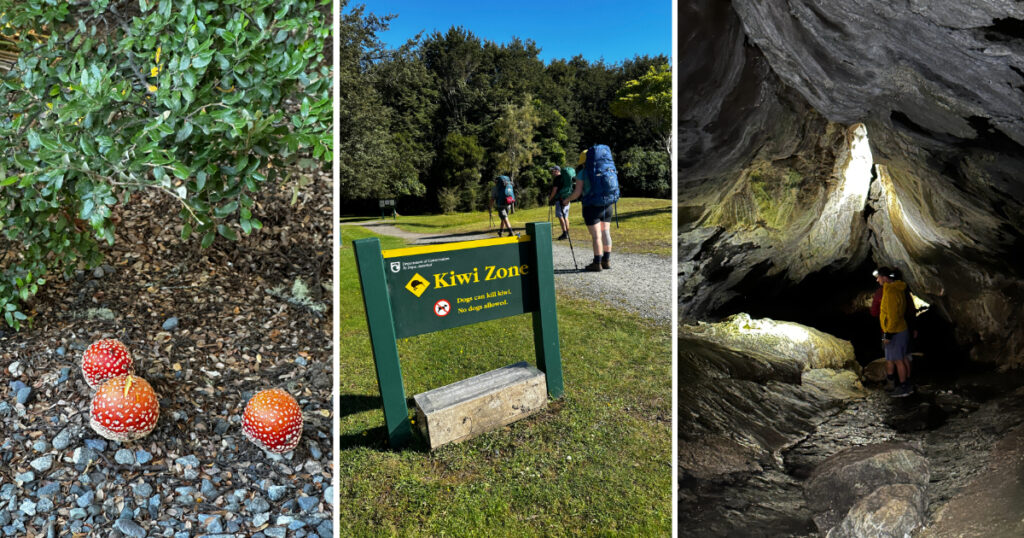
The takahē (below) was declared extinct for almost 50 whole years before they were rediscovered in 1948! I think that’s pretty amazing. They’re my favourite bird. The department of conservation has worked hard to help increase the population from nearly 0 to about 500. All of this to say: If you’re lucky, you may be able to spot a takahē along the Kepler Track.
We weren’t so fortunate, but we did hear kiwi birds screaming in the middle of the night. (Don’t worry, that’s just what they do.) If you really want to go kiwi “hunting,” you can bring a headlamp with a red light feature and stay up late at Motarau Hut. I couldn’t bring myself to do it because I wanted to be well-rested, but a guy in our hut did sacrifice some sleep and actually saw them!
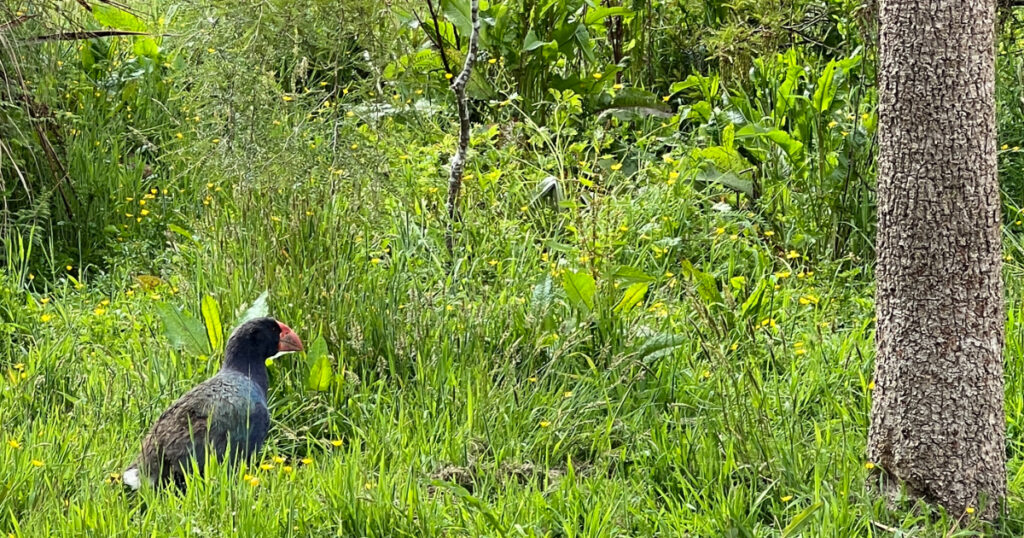
Takahē at the Te Anau Bird Sanctuary
Fees for the Kepler Track huts
For the 2024/25 season, the cost of one night in a hut is $80 for locals and $120 for international hikers. I know this seems expensive, but remember there is no entry fee for any national parks across the country! The somewhat steep price of these basic huts goes right to the Department of Conservation (DOC) budget and keeps New Zealand’s stunning trails safe and accessible for everyone.
Most people take their time and enjoy the Great Walk over 4 days and stay in all 3 huts. (That’s what I did!) But if you’re super fit and want a challenge — or just really don’t want to pay for a third night — it’s possible to do the track in 3 or even 2 days. Not gonna lie though, 2 days seems insane to me. It’s 60 kilometres and not flat.
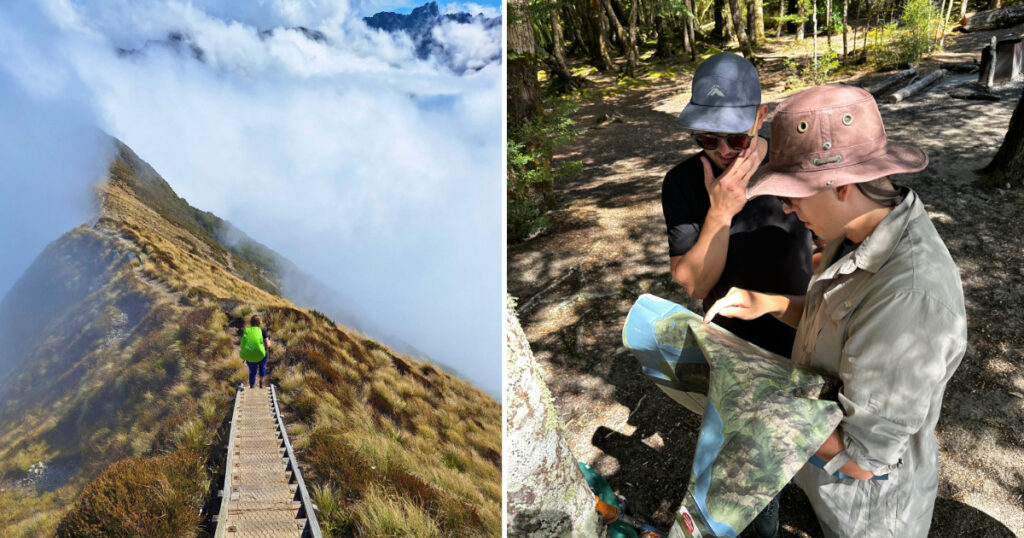
So 3 nights in the Kepler Track huts costs a total of $240 if you have local ID, or $360 if you’re visiting from abroad. You don’t have to be a New Zealand citizen or permanent resident for this perk, you just have to be living here. A driver’s license will work.
You can book the Kepler Track huts here. The main season runs from October to April. And spots in the huts fill up pretty quickly during this time, so book ASAP! It’s possible to do the loop track in either direction, but I highly recommend going anti-clockwise, where Luxmore Hut will be your first stop. That’s what most people do, and with good reason. It makes the track a little easier, and means your last day will be pretty smooth, flat sailing rather than steep downhill. (Your knees will thank you.)
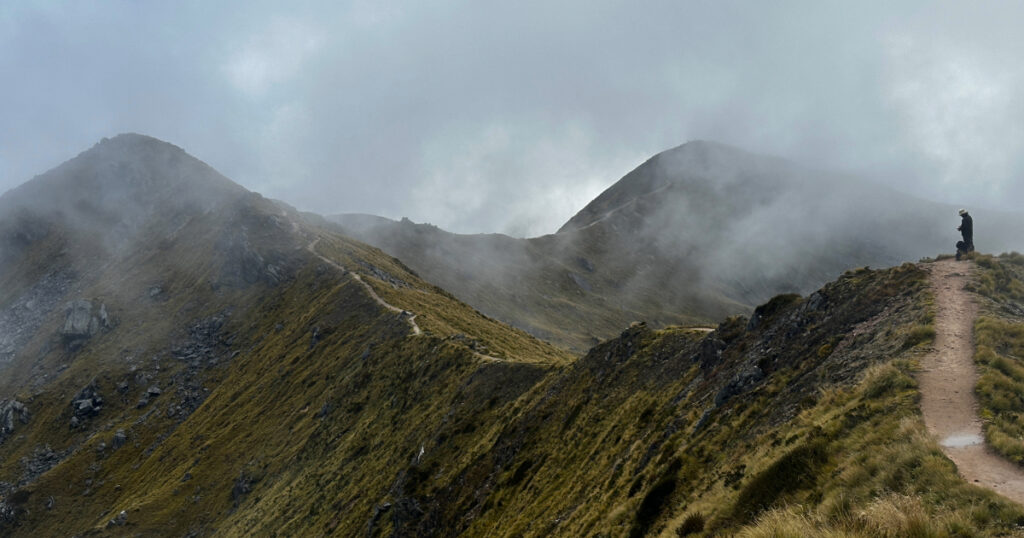
Getting to the Kepler Track
This is one of the easiest tracks to access. Unlike the Milford Track, where you’ll need to shell out a few hundred dollars for a bus and boat transfer on either side of the trail, the Kepler Track starts and ends at the same point.
There’s a parking lot just outside of Te Anau and it’s safe to lock and leave your car there for the duration of the hike. People come and go all the time for shorter day hikes.
Te Anau is two hours from Queenstown, so you could get up early to get to the track to start your hike. But Queenstown is probably going to be more expensive, and if you stay in Te Anau you can sleep in a little!
Read more: The Total Cost of Hiking the Milford Track
Activities near the Kepler Track
Before or after your hike, make sure you tack on some time to enjoy the surrounding area! Te Anau is so beautiful and often gets overlooked as a simple stopover on the way to Milford Sound. But I beg to differ.
- Te Anau Bird Sanctuary. If you don’t get to catch a glimpse of the elusive takahē on your Great Walk, you can see them here. (If you can afford it, bring a little cash to leave in the donation box to help support the conservation projects and keep these chubby little birds alive.)
- Te Anau Glow Worm Caves. This trip is kinda a two-for-one because you’ll need to take a scenic boat ride across to the caves. This is definitely THE place to see glow worms on the South Island.
- Day trip to Milford Sound. This is (one of many) 8th Wonders of the World. Most people book a cruise through the fjords. But since you’re reading this, you’re probably an avid hiker. There are lots of beautiful trails in the area if your legs aren’t screaming at you. You can catch a boat over to an easy day walk on the last stretch of the Milford Track. (So you can say you finished the Kepler Track and a quarter of another Great Walk.
- Fly over the park you just hiked through. If you’re ready to splurge on an amazing experience, you can catch a helicopter or float plane over Fiordland National Park and see the Kepler Track from above. Maybe you’ll spot the legendary moose that some people believe still live somewhere in the 1.2 million hectares of the park.

